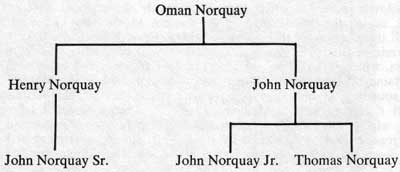by Ellen Cooke
Manitoba Pageant, Winter 1976, Volume 21, Number 2
|
It is generally agreed that the John Norquay who was later to become premier of Manitoba took no active part in the troubles of 1869-1870. But on occasion he has been confused with two of his relatives, as follows:
1. His brother Thomas, who carried messages between the Portage la Prairie force and Riel.
2. His cousin, John Norquay Senior, who was elected to the council of Riel’s provisional government.
The abbreviated family tree set out below shows how easily one member of a Red River Settlement family can be mistaken for another; it will be noted that there are three John Norquays in only two generations.

Oman Norquay’s son John does not enter into the present discussion, because parish records show that he died twenty years before the troubles of 1869-1870.
This leaves the three Norquays who have been confused with one another: the brothers John and Thomas, and their cousin John. The fact that John Senior was a cousin of the other two Norquays is suggested by parish records, and was confirmed some years ago by one of the premier’s sons and by a more distant relative.
It was in February and March 1870 that Thomas Norquay and John Norquay Senior were caught up in the political storm then sweeping through the Red River Settlement.
Early in February 1870 a party of Canadians in Portage la Prairie set out on the sixty-mile journey to Fort Garry, with the idea of freeing prisoners held by Riel.
The Portage men picked up recruits as they passed eastward through settlements along the Assiniboine River road, beginning with High Bluff, eight miles east of Portage la Prairie.
Residents of High Bluff included John Norquay Senior and John Norquay Junior. This is shown by the appearance of their names on the certificate of election for St. Margaret’s Parish, High Bluff, dated only a fortnight later. There is nothing to indicate, however, that either cousin joined the Portage force.
The Canadians made their way past Fort Garry in darkness, turned north along the Red River road, and stopped at Kildonan, five miles north of Fort Garry.
At that time Thomas Norquay was living eleven to sixteen miles north of Kildonan; parish records describe him as a schoolmaster at Little Britain in January 1869 and at St. Andrew’s in September 1870.
On grounds of location alone, therefore, it seems that the Canadians would have chosen Thomas as their messenger to Riel, rather than one of the John Norquays, whose homes were roughly fifty miles to the west.
Tradition also favors the Canadians’ choice of Thomas Norquay. Descendants of both Thomas and his brother the premier agree that it was Thomas who carried messages between Kildonan and Fort Garry.
In addition, early historians, closer to the event, identified the messenger as Thomas Norquay.
The Canadians had demanded, in their message to Riel, that he free the prisoners held at Fort Garry. In his reply Riel stated that the prisoners were all out.
After receipt of Riel’s message the Portage group set out for home, but Riel’s men saw them as they passed Fort Garry and took them prisoner. Riel then called for parish elections.
St. Margaret’s Parish, High Bluff, returned John Norquay Senior as their representative in the council of Riel’s provisional government. The election certificate, dated 1 March 1870, was signed by John Norquay Junior and George Adams.
Which of the two John Norquays appearing on this certificate was the future premier? Was it Riel’s councillor, John Senior, or the man who signed as John Junior? Evidence shows that it was John Junior.
In Manitoba’s Legislature, down to the premier’s death in 1889, there was only one Norquay, and the records make it clear that he was John Norquay Junior.
The Journals of the Legislative Assembly of Manitoba covering the lust two sessions—1871 and 1872—include a list of members. In 1871 the name of John Norquay is followed by “Jun’r” and in 1872 by “jr.”
Norquay first entered the cabinet in December 1871. He was described at that time as “John Norquay jr.” in his Oath of Allegiance. Moreover, his signature to both his Oath of Allegiance and his Oath of Office as Minister of Public Works and Agriculture is in the same handwriting as that of John Norquay Junior on the St. Margaret’s Parish election certificate of March 1870.
One of the premier’s sons said that his father had nothing to do with the disturbances of 1869-1870, and the information given above supports that statement as far as active participation is concerned.
It is said, however, that the premier did exert a calming influence. The Parliamentary Companion for 1885 and later years credits him with taking a moderate stand in discussions of the time and thereby winning wide support. Perhaps this confidence accounts in part for his return by acclamation for High Bluff constituency in Manitoba’s first election.
Page revised: 2 March 2015